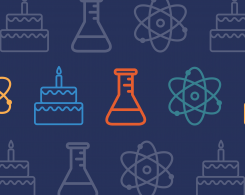Today in Science Blog Posts

Nanodiamonds Shine Brightly in Biomedical Research
A nanodiamond might not be ideal for an engagement ring, but these microscopic particles show a potential role in observing and analyzing cell processes. Learn more >>

The Mystery Behind the Earth’s Magnetic Field Flip
Earth’s magnetic field typically remains stable. However, studies have shown that throughout history, geomagnetic reversals have occurred — irregular intervals when Earth’s magnetic field flips.

An Idea that Is Taking Off: Next-Generation Spacesuits
Researchers at MIT are designing a next-generation spacesuit that relies less on gas pressure and instead moves toward the idea of applying pressure directly to the skin. Get details here.

Sea Life Offers New Insight into Underwater Adhesives
Underwater adhesives are an important biomedical innovation. To design stronger synthetic waterproof materials, researchers are gaining inspiration from undersea creatures like mussels and worms.

Happy Birthday, Michael Faraday
Did you know that Michael Faraday is credited with discovering electromagnetic induction in 1831? Learn more about this British physicist and chemist.

Shape-Memory Polymer May Help in Facial Reconstructions
Researchers at Texas A&M developed a shape memory polymer that can potentially be used to fill in critical-sized bone defects in the human face. Get the full story here >>

The Evolution of Night Vision Technology
Night vision glasses have existed since World War II, but they used to be so bulky that they were inconvenient to use. Learn about the design evolution from active to passive infrared technology.

Physics Make or Break the Comic Book Movie Illusion
The animation team behind the 2014 film The Amazing Spider-Man 2 attempted to comply with the laws of physics while making the movie. Get an overview of the different phenomena they considered.

Why Room Acoustics Matters
How come a recorded soundscape is never as satisfying as listening to the real thing? The answer lies in the phenomenon of room acoustics. Get a comprehensive overview of this concept here.

Shaping the Future with Holography
Did you know that holography was first developed by Dennis Gabor in 1948? Because of his discovery, he was awarded the Nobel Prize in Physics in 1971. See how the field has expanded since then.

Hygroscopy of Brown vs. White Sugar, the Banana Bread Test
Physics in the kitchen: We bake 2 loaves of vegan banana bread to compare the hygroscopic properties of white and brown sugar. Get details — and the recipe! — on the blog.

Infrared Pothole Repair: A More Permanent Solution
Potholes are an annoying reality for anyone who drives a car. We discuss how potholes form in asphalt and a potential way to permanently repair them using infrared technology.

Vinyl Records: A Sound All Their Own
Here’s a piece of music trivia: Vinyl records can be traced back to the development of the phonoautograph in 1855 by Édouard-Léon Scott de Martinville.

Designing Future Technologies with Gallium
Here’s a piece of element trivia: Gallium’s existence was first predicted by Dmitri Mendeleev in 1871, but it was not discovered spectroscopically until 1875 by Lecoq de Boisbaudran.

Magnetic Cooling Technology in Refrigeration
Is your refrigerator running? Then you better go catch it (and see if it uses magnetic cooling technology, which offers a greener approach to preserving foods)!

Selective Laser Sintering for Prototype Production
A type of 3D printing called selective laser sintering is used to produce everything from metal prototypes and plastic, ceramic, and glass materials to coffee! Learn about modeling this process.

The Hygroscopic Swelling Effect
If you put a quarter cup of rice in a pot of water, you end up with half a cup of rice. This isn’t magic — it’s simply hygroscopic swelling at work. Learn more about this phenomenon.

What Is a Packed Bed Reactor?
Absorption, distillation, stripping, separation processes, catalytic reactions — the list goes on! All of these chemical processing applications require the use of a packed bed reactor.

Treating Damaged Biological Tissue with Cryotherapy
Ever hear of cryotherapy (also called “cryosurgery”)? This superfreezing method uses low temperatures to treat damaged tissues, typically with the help of liquid nitrogen.

The Age of 3D Metal Printing
3D printing (also called additive manufacturing) can involve the use of plastics and metals. Take a more in-depth look at 3D metal printing and its potential to revolutionize manufacturing here.

Eat First, Research Later: Exploring the Role of Eggs in Baking
Leavening, binding, moistening: 3 of the roles eggs typically play in baking. Learn more about the science behind baking with eggs, and how vegan baked goods compare, on the blog.

Solving a Space Problem with Origami Principles
From spacecraft to solar panels, lack of space is a design problem. Read about how some researchers are using origami, the ancient art of Japanese paper folding, to remedy this issue.

Happy Birthday, Nikola Tesla
From discovering the rotating magnetic field to inventing the Tesla coil, Nikola Tesla made countless contributions to science and physics. Learn about the life and work of this household name.

Vacuum Tube Plus MOSFET Equals Vacuum Transistor
One potential way to replace traditional silicon transistors? Develop vacuum transistors, which combine vacuum tubes and metal oxide semiconductor field-effect transistors (MOSFETs).
